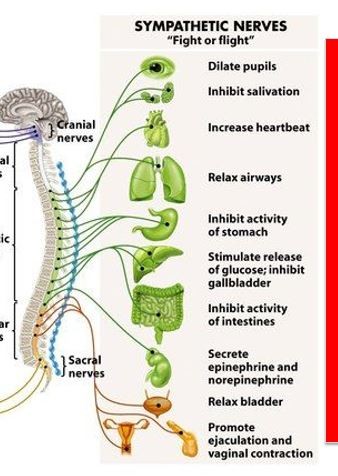Ganglion
cluster of neurons cell bodies within the PNS
Center
Group of CNS neuron cell bodies with a common function
Nucleus
Center that displays discrete anatomic boundaries
Nerve
Axon bundle extending through the PSN
Nerve plexus
Network of nerves
Tract
CNS axon bundle in with the axons have a similar function and share a common origin and destination
Funiculus
Group of tracts in a specific area of the spinal cord
Pathway
Centers and tracts that connect the CNS with body organs and systems
Gray vs white matter
Gray matter
-Neuron cell bodies
-Dendrites
-Unmyelinated axons
-Brain (gray outside, white inside)
brain stem
-Spinal cord (white outside, gray inside)
White matter
-Myelinated axons
How are nerves organs
made of nervous & connective tissue, and blood vessel
Dorsal root vs ventral root of spinal cord
Dorsal root
- sensory neuron axons ONLY
Unipolar neuron cell bodies located in posterior root ganglion
dorsal root ganglian- soma is outside CNS (Afferent)
Ventral root
-motor neuron axons ONLY
- anterior horn of gray matter in cord
-Efferent fibers - soma is inside CNS (nucleus
Layers of the Meninges
Dura mater- tough outside layer
Arachnoid Mater- filled with intricate “web” of collagen (barrier for CNS)
subarachnoid- cerebral spinal fluid
Pia Mater- Innermost layer; lines every sulci and gyri of the hemispheres, contours brainstem, and all folds of cerebellum (produces cerebral spinal fluid)
Blood brain barrier cells
Endothelial- bodyguard for top people
Pericytes-
Regulate cerebral blood flow and BBB permeability by cell signaling to astrocyte, endothelial and neurons
Astrocyte- communication with endothelial and pericytes
-influence express of pump, receptors, mechanisms
-support energy supply
Cerebral spinal fluid
-liquid surrounding brain and spinal cord formed in choroid plexus by ependymal cell and flows in subarachnoid area
-physical support
-controlled chemical environment -> nutrient and waste removal
How CSF is produced and travels
Produced in choroid plexus
-flow through ventricles and into subarachnoid space
-absorbed into dural venous sinuses via arachnoid villi
Cerebral cortex and function
-thin gray outermost portion of cerebrum, 75% of all neurons in nervous system
-Ultimate control/information processing center
Pituitary function
Master endocrine gland
Midbrain function
motor movement (eye, auditory, visual)
Pons function
Breathing, Hearing Taste, balance
Spinal cord function
Pathway to neural fibers traveling to/from brain. Simple reflexes
Medulla oblongata function
Regulate breathing, heart and blood vessel
Cerebellum function
voluntary movement. Balance and memory
Amygdala function
emotions ( reward, fear, social functions)
Hippocampus function
memory, cognition (long term memory, map navigation, spatial memory)
Fornix function
Carries signal from hippocampus to mammillary bodies and septal nuclei
Thalamus and function
relay motor and sensory messages (except smell) between lower brain and cerebral cortex
-large group of nuclei in diencephalon
-left/left lobe connected by interthalamic adhesion/intermediate mass (travel through third ventricle
Corpus Callosum function
Axon fibers connecting 2 cerebral hemisphere
Cerebrum vs cerebral cortex
Cerebrum
prominent, anterior part of vertebrate brain (2 hemisphere)
-Both gray and white mater
-cell body and nerve fiber
-control voluntary muscle movement
Cerebral cortex
-outer layer of cerebrum
-folded grey matter
-cell bodies and dendrites
-4 lobes
-consciousness
The cerebral hemisphere is divided by___
longitudinal fissure
white tract: corpus callosum
Gyri and sulci
Gyri- increase surface area
Sulci- some divide into 5 lobes (frontal, central, parietal, occipital)
Functional specialization of 2 cerebral hemisphere
cerebral lateralization
left hemisphere: language production
right hemisphere: visuospatial
Frontal, Parietal, occipital, temporal lobe
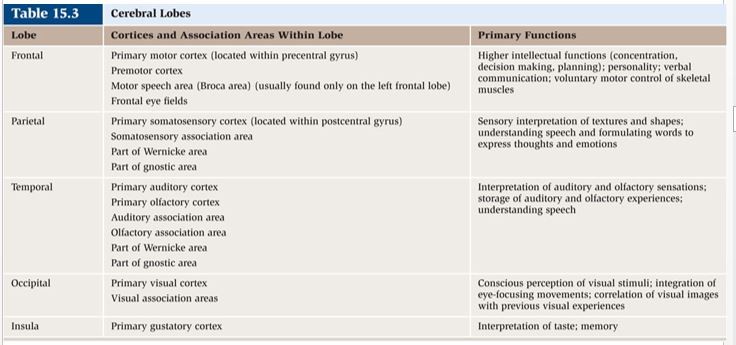
Frontal lobe
Reasoning, planning, speech, movement, emotions, problem solving
Parietal
Movement, orientation, recognition, perception of stimuli
Occipital
Visual
Temporal
Perception, Hearing
homunculus and 2 different areas
homunculus- amount of brain tissue devoted to each sonsory/motor functions
Primary somatosensory area -site where sensation originate
Primary motor area - generate action potential for movement, receive info from lobes of brain from d
Motor Areas
•Primary Motor Cortex (somatic motor area)—voluntary skeletal muscle activity; located within the precentral gyrus
•Motor Speech Area (Broca’s Area)— movements for vocalization; located within the inferolateral portion of the left frontal lobe
•Frontal Eye Field—regulates eye movements and binocular vision; located immediately anterior to the premotor cortex
Sensory Areas
•Primary somatosensory cortex—receives general somatic sensory information from touch, pressure, pain, and temperature receptors; located within the postcentral gyrus
• Primary visual cortex—receives and processes incoming visual information; located in occipital lobe
• Primary auditory cortex—receives and processes auditory information; located in temporal lobe
• Primary gustatory cortex—processes taste information; located in insula
• Primary olfactory cortex—provides conscious awareness of smell; located in medial temporal lobe
Limbic system
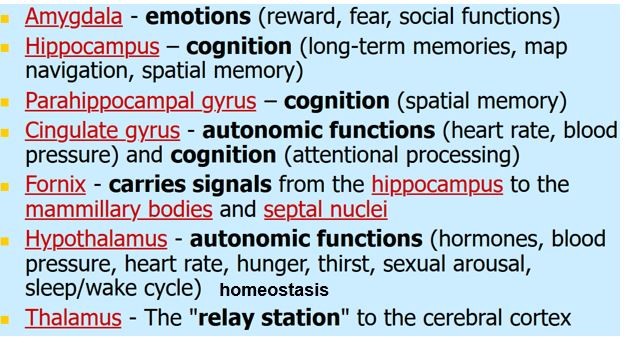
-under cerebrum
Functions of the Hypothalamus
Master control of the Autonomic Nervous System
and Endocrine System (emotion and reward)
-body temperature
-certain emotions and sex drive
-thirst and hunger
-hormones, growth
-metabolism
-water and electrolyte balance
blood pressure,
sleep,
homeostasis
Basal Nuclei/ basal ganglia
coordinating skeletal muscle contraction
Comprised of nuclei:
-Caudate nucleus
-Lentiform nucleus
-Putamen
-Globus pallidus
parkison disease
Cerebellum function
muscle tone, coordination of movement, posture/balance, eye movement, motor learning, cognitive function (language, riding bike)
-influence ipsilateral(same) side of body
-compare motor plan (intent) in cortex with motor performance (from periphery) and smooth them
-synaptic contact with brain stem "motor" and cerebral hemisphere
Brain stem
Control info from brain and body, breathing, swallowing heart rate, blood pressure, conscious
Diencephalon of thalamus (relay/process sensory info) and hypothalamus(emotions, autonomic, hormone)
Midbrain-connects pons and medulla oblongata
-process auditory and visual. create reflexive somatic motor response. maintain consciousness
Pons-relay sensory into to cerebellum and thalamus
Medulla oblongata- relay sensory info thalamus and other brainstem. regulation of visceral function (cardiovascular, respiratory, digestive)
short term memory vs long term memory
Short term- hold 7-12 info for hours, disappears
Long term- hold large amount of info for days/years.
Converted from short by consolidation
need break and repetition
What makes up the PNS
Sensory (afferent) transmit action potential from receptor to CNS
Motor (efferent) transmit action potential from CNS to effectors (muscle, glands)
Functions of sensory pathways
Sensory reception (detect stimuli inside and outside body), transduction, transmission, integration
Simple, complex, and special sensory receptors
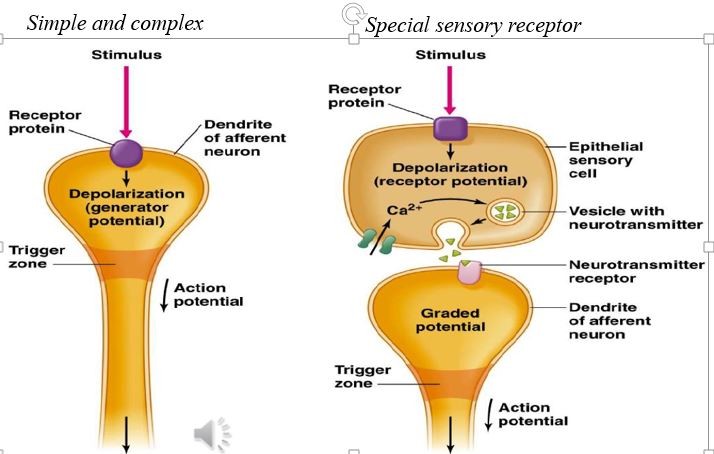
Simple- neurons with free nerve ending (pain, tickle, itch, temp)
Complex- have nerve endings enclosed in connective tissue capsules (touch, pressure, vibration)
Special sensory receptors- cells that release neurotransmitters onto sensory neurons initating action potential (vision, hearing, taste, smell)
Transduction
conversion of stimulus energy (light, heat, touch, sound, etc into nerve signal by
EX transducers: sense organ, gasoline engine
sensation
subjective awareness of stimulus
most sensory signals delivered to the CNS produce no conscious sensation
-filtered out in the brainstem
-some do not require conscious awareness like pH and body temperature
All sensory receptors ______ incoming stimuli into changes in membrane potential (can lead to action potential)
transduce
CNS interpretation of stimuli depends on 4 properties
Modality, Location, Intensity, Duration
What is modality and the 6 major receptors?
Modality- which type of environmental stimuli do our neurons sense?
Mechanoreceptors-pressure, touch vibration, stretch, itch, proprioception and equilibrium
Thermoreceptors- temperature
Photoreceptors-electromagnetic radiation
Chemoreceptors-chemicals; taste, smell , changes in body fluid chemistry
Nociceptors-tissue damage
Osmoreceptors– detect changes in concentration of solutes
3 Location of receptors
Interoceptor- monitor internal systems of organ and blood vessel
(chemoreceptor for O2, baroreceptor for blood pressure, mechanical receptor stretch in organ)
Exteroceptor- external senses (touch, temp, pressure)
-distance sense (seeing, hearing, smelling)
Proprioceptor- monitor position and movement (skeletal muscle and joints)
Size of receptive field (sensitivity) is dependent on ___
location
fingers have smaller more # touch receptor than forearm
What is lateral inhibition
fine tuning of signal
excited neuron reduce activity of neighbor, depends on location
Intensity is dependent on
frequency of action potential
Receptor adaptation (duration) Tonic vs phasic
Tonic receptor- slowly adapting receptors that respond for the duration of a stimulus (constant firing)
Ex- stretch receptor, pain receptor, photoreceptor, mechanoreceptor
Phasic receptors- rapidly adapt to a constant stimulus and turn off
Ex-smell, pressure, touch, temp
7 senses and their receptors
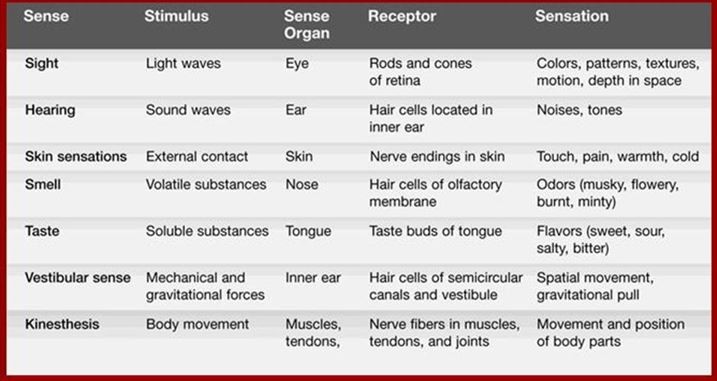
Sensation & Perception
Sensation- awareness of changes
-stimulation of receptor
Perception
conscious awareness & interpretation of sensation
generate action potential then to brain
Somatosensory pathway
First order neuron- soma in dorsal root ganglion or cranial ganglion (environment to spinal cord/brain stem)
Second order neuron- soma in brain stem, dorsal root and medulla it travels to thalamus
Thirds order neuron- thalamus to sensory area of cerebral cortex
Upper motor neuron vs lower motor neuron
Upper motor neuron- Carry motor output from cerebral cortex and brain stem to lower motor neuron in spinal cord/brain stem
Lower motor neuron- in anterior gray horn of spinal cord that innervate muscle
What system is involved in movement?
nervous, skeletal, and muscular
3 neurons that work together for sensation
sensory neuron, upper motor neuron, lower motor neuron
Neurotransmitters involved in ANS
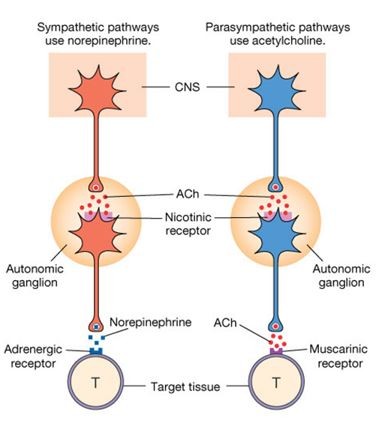
Sympathetic- preganglion release ACH and post release norepinephrine
Parasympathetic- preganglion release Ach- Post release ACH/norepinephrine
Parasympathetic vs sympathetic
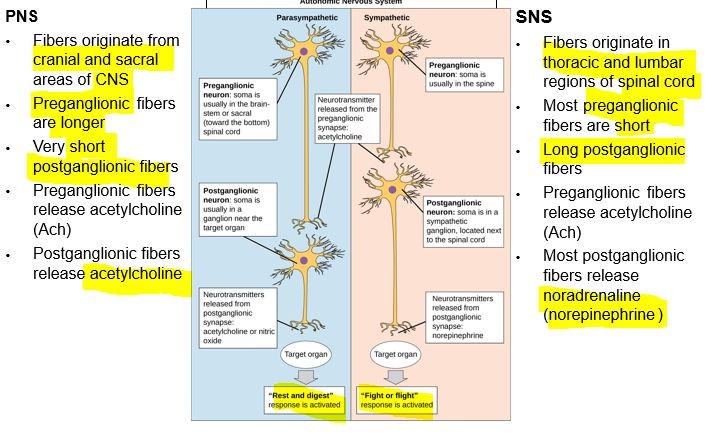
Most visceral organs innervated by both
In autonomic nervous system, ____ neuron innervate tissue form and diffuse. ___ are site of neurotransmitter release
postganglionic
Varicosities
Single unit (visceral) vs multi unit smooth muscle
Single unit- cells connected by gap junction that act as group. Walls of hallow organs (viscera)
Multi-unit- contract individual cells. iris of eye, walls of blood vessel
Organs with sympathetic innervation only
-adrenal medulla
-arrector pilli- goose bump/hair stands up
-blood vessel
-sweat glands
regulation through increase/decrease firing rate by sympathetic neurons
Autonomic nervous system maintain homeostasis
through balance of sympathetic "fight or flight"
parasympathetic "rest and digest"
What area of brain control autonomic control center?
Hypothalamus- water balance, temp, hunger
Pons- respiration, cardiac, vasoconstriction
Medulla- respiration
Location of autonomic nervous system
Preganglionic neurons- in CNS, release ACH(excitatory)
Post ganglionic neuron- ganglia outside CNS
Some functions of sympathetic
increase
heart rate, blood pressure, vasodilation in blood vessel, diameter of respiratory airway(max air), glycogen, sweat,
decrease digestion, urine production
structure of sympathetic
preganglionic neuron- short, branched, cholinergic neuron
Postganglionic neuron- long, adrenergic neuron
Neurotransmitters of sympathetic
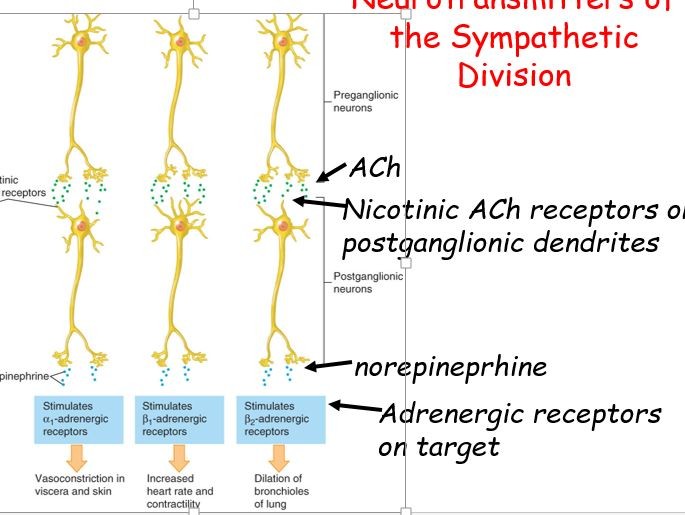
Preganglionic neuron –cholinergic -> release ?
->binds nicotinic Ach receptors on postganglionic neurons
excitatory!
Postganglionic neuron – adrenergic neurons
usually release ?
excitatory or inhibitory depending on type of adrenergic receptor it binds on target
sympathetic nervous system and age
↑ age -> ↑ levels of sympathetic activity
may increase hypertension & cardiovascular disease
parasympathetic structure
Preganglionic neurons:-origin: brain or spinal cord. long, cholinergic
Postganglionic neurons:-origin: outside CNS near/in effector organ. -short, usually cholinergeric
Vagus nerve –major nerve carrying preganglionic axons of parasympathetic
Neurotransmitters of the Parasympathetic Division
Preganglionic neuron -> releases ?
-binds nicotinic receptors on postganglionic cell -excitatory
Postganglionic neuron ->releases ? (some release NO)
-ACh binds muscarinic receptors
-inhibition (IPSPs) in heart
-excitation (EPSPs) in digestive tract
Somatic Motor Controls
•Body movement/skeletal muscle
•Appendages
•Locomotion
•Single neuron
-CNS origin
-Myelinated
•Terminus
-Branches
-Neuromuscular junction
3 types of muscle
skeletal, smooth, cardiac
chemical energy into mechanical energy
Skeletal muscle
repeating sarcomeres (striated)
myosin and actin
attach to bones through tendons
smooth muscle
line walls of hallow organs and blood vessel
Nonstriated and under involunatry control
cardiac muscle
striated,
intercalated disc
involuntary, autorhythmic
skeletal muscle act in antagonistic pairs-
one contract and another return to position
Skeletal muscle
contraction = shortens
moves tendons and bones
voluntary control
contract rapidly but tired easily
overall body motility
T tubules and SR
T tubules bring action poetntial into muscle fibers
Depolarization cause sarcoplasmic reticulum to release calcium
Myofibril
Muscle fiber contains many myofibril (A band, I band, Z line)
myofibril contain many sarcomere
myofilament (action and myosin)
Sarcomere
Basic contractile of muscle unit, between 2 Z line
M line, central myosin filament anchor
H zone- only myosin
I band-only actin filament
A band -myosin and actin
Thick filament and thin filament
Thick filament (myosin) 2 gobular head and tail
Thin tilament- actin with tropomyosin and troponin
Sliding filament model
muscle contract- chemical to mechanical
-Nervous system changes in pulmary potential
-myosin head of thick bind to actin of thin propel toward M line
- H zone, sarcomere, muscle cell, whole muscle shortens
How motor neurons influence contraction of muscle
by causing change in membrane potential
Motor cortex- generate motor action potential
cerebellum= smooth action
down to spinal cord then muscle
Motor units
muscle made of many motor units
Motor unit: made up of motor neuron and muscle fibers(either fast or slow twitch) within the muscle it innervates
-Groups of motor unit often work together
-All motor units that subserve single muscle are considered a motor unit pool
link between the action potential (generated in the sarcolemma) and the start of a muscle contraction
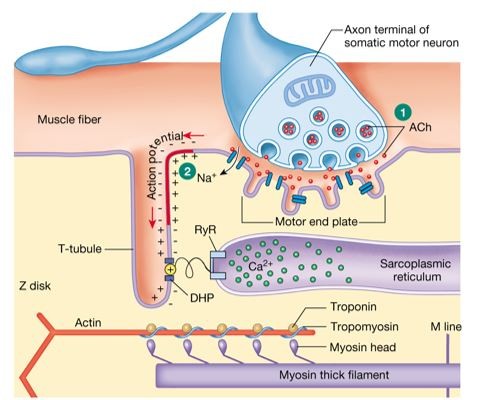
-Action potential gets picked up by voltage gated Ca+ channels.
-Ca+ flows in and it releases Ach. Ach bind to motor end plate and flow of Na+ inside.
-Na+ polarize muscle fibers. Action potential travel to T tubules (bring in action potential.
-DHP activated and linked to RyR that release calcium into cytoplasm
-calcium bind to troponin cause tropomyosin to move and expose myosin. Myosin and actin bind (z disc move closer to m line with calcium and ATP)
sliding filament theory steps
1. muscle contractions begin and continues if ATP available and Ca++ in sarcoplasm is high
2. Ca++ released and bind to troponin which cause tropomyosin to release and expose actin
3. Myosin head and actin form cross bridge with help from Ca+
4. ADP and P release, Powerstroke slide thin filament. Sarcomere & Z line shorten (muscle contract)
5. ATP bind to myosin cause detachment
6. Hydrolysis of ATP "cock" myosin head
Muscle relaxation
-acetylcholinesterase decomposes acetylcholine
-calcium pump back in SR
-tropomyosin cover myosin binding site
-sarcomere relax and back to normal length
Reflexes
involuntary motor response without conscious control.
-short neuronal circuits =quick reaction
-involve spinal cord or brain stem
-fast, higher brain center not involved (few synapses)
Reflex purpose
•Protect from tissue damage
•homeostasis
•optimal muscle length for strong contraction
All have similar properties
-stimulus required
-few neurons involved
-preprogrammed response is the same way every time
-involuntary response requires no intent or pre-awareness
Reflex Arc
-Stimulus activates receptor
-Nerve impulse travel through sensory neuron to spinal cord
-Nerve impulse processed in by interneurons
-Motor neuron transmits nerve impulse to effector
-Effector responds to impulse from motor neuron
Monosynaptic and polysynaptic reflexes
Monosynaptic- direct communication between sensory and motor neuron (knee flex)
Polysynaptic reflex-interneuron faciliates sensory motor communication (hot stove)
Autonomic reflexes
Polysynaptic with 1 synapse in CNS and another in Autonomic ganglion
3 functions of meninges
- protect from mechanical injury
-provide blood supply to skull
-provide space for cerebrospinal fluid
Mechanoreceptors
pressure, touch vibration, stretch, itch, proprioception and equilibrium
Thermoreceptors
temperature
Photoreceptors
electromagnetic radiation
Chemoreceptors
chemicals; taste, smell , changes in body fluid chemistry
Nociceptors
tissue damage
Osmoreceptors
detect changes in concentration of solutes
Parasympathetic nerve effect on pupil, heart, airway, stomach, intestine, bladder

Sympathetic nerve effect on pupil, salivation, heart, airway, stomach, intestine, bladder
